Scientists Recreate Aztec Death Whistle’s Deathly Noise
Experts have recreated the terrifying sound of the Aztec Death Whistle - using a 3D printer. The whistle's design is based on the skull-shaped originals found in Mexico in the 1990s. Historically, this whistle might have been used by Aztecs in ceremonies honoring the wind god, Ehecatl, before their sacrifice, but its distinctive and terrifying sound was also weapon of psychological warfare.
A video showcasing the 3D-printed whistle's sound, labeled the "The Scariest Sound in the World," was posted by the Action Lab on YouTube. The original whistle's discovery in 1999 was initially categorized as a toy, but its chilling sound resembling a human scream was later revealed. While the whistle's exact purpose remains uncertain, some believe it aided souls in transitioning to the afterlife post-sacrifice.
The Aztec Death Whistles were Not Common Instruments
When odd, skull-shaped grave items were found by archaeologists decades ago at an Aztec temple in Mexico, they were assumed to be mere toys or ornaments, and were catalogued and stored in warehouses. However, years later, experts discovered they were creepy ‘death whistles’ that made piercing noises resembling a human scream, which the ancient Aztecs may have used during ceremonies, sacrifices, or during battles to strike fear into their enemies.
Two skull-shaped, hollow whistles were found 20 years ago at the temple of the wind god Ehecatl, in the hands of a sacrificed male skeleton. When the whistles were finally blown, the sounds created were described as terrifying. The whistles make the sounds of “humans howling in pain, spooky gusts of whistling wind or the ‘scream of a thousand corpses” wrote MailOnline.
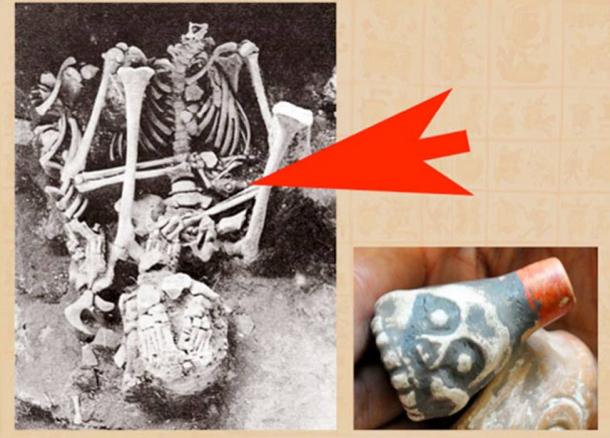
Skeleton of a man buried at the wind god temple, Tlatelolco, with an Aztec death whistle (indicated). (Roberto Velázquez)
Roberto Velázquez Cabrera, a mechanical engineer and founder of the Mexico-based Instituto Virtual de Investigación Tlapitzcalzin, spent years recreating the instruments of the pre-Columbians to examine the sounds they make. He wrote in MexicoLore that the death whistle in particular was not a common instrument, and was possibly reserved for sacrifices – blown just before a victim was killed in order to guide souls to the afterlife, or for use in battle.
- Religion of the Aztecs: Keeping the Balance in an Unpredictable and Terrifying World
- The Lost City of Aztlan – Legendary Homeland of the Aztecs
- Art of an Empire: The Imagination, Creativity and Craftsmanship of the Aztecs
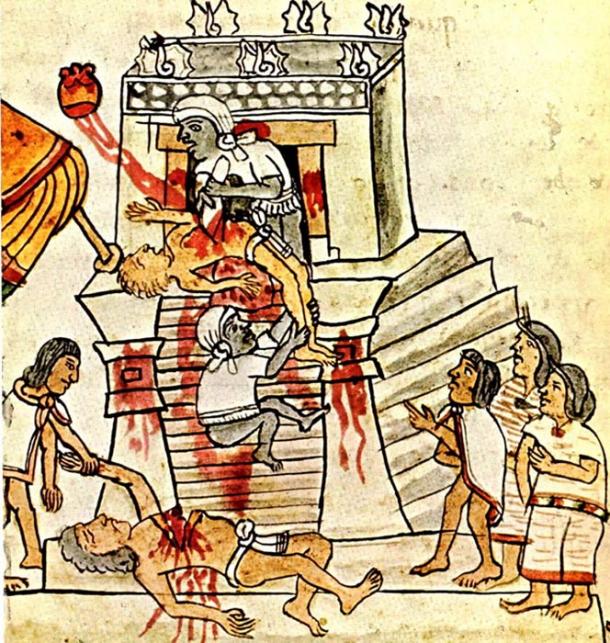
Aztec ritual human sacrifice portrayed in the Codex Magliabechiano. (Public Domain)
Why Did the Aztecs Use the Death Whistles?
“Some historians believe that the Aztecs used to sound the death whistle in order to help the deceased journey into the underworld. Tribes are said to have used the terrifying sounds as psychological warfare, to frighten enemies at the start of battle,” explains Oddity Central. If the whistles were worn around the necks of Aztec warriors and then used to shock their enemies at the beginning of battles, the psychological effect on an enemy of a hundred death whistles screaming in unison might have been great, unhinging and undermining their resolve.
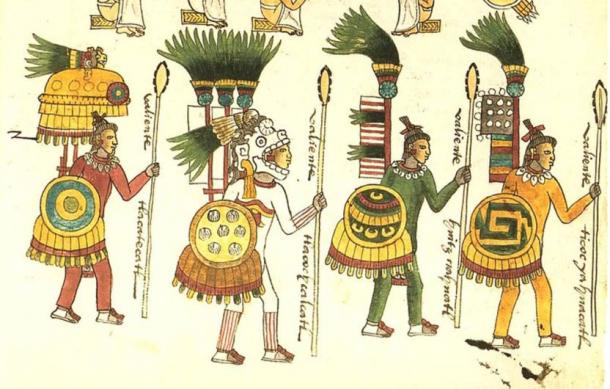
Illustration of Aztec Warriors as found in the Codex Mendoza. (Public Domain)
Another hypothesis proposes that the sacrificed man was given the whistles so he could blow into them after he died and use the spirit of the wind to guide him safely through the Underworld.
Los Angeles Times reported that some experts think the ancients used the different tones to send the brain into certain states of consciousness, or even to manage or treat illnesses. Some of the replica whistles created by Cabrera make sounds and tones reaching the top range of human hearing, almost inaudible to us.
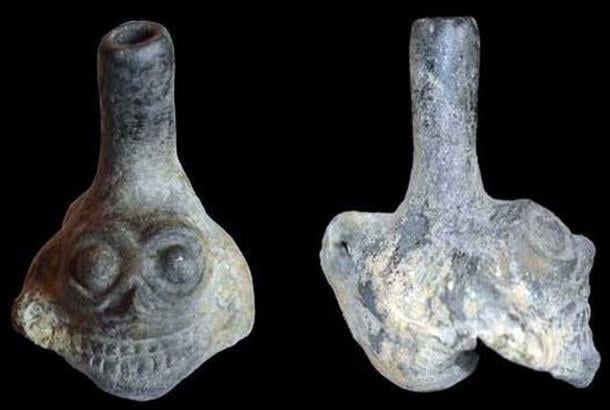
Photos of a cremated Aztec death whistle, by Jorge Cervantes Martínez. (Mexicolore)
An expert in pre-Hispanic music archaeology, Arnd Adje Both told Los Angeles Times "My experience is that at least some pre-Hispanic sounds are more destructive than positive, others are highly trance-evocative. Surely, sounds were used in all kind of cults, such as sacrificial ones, but also in healing ceremonies.”
Other types of ancient noisemakers have been found made from different materials, such as feathers, sugar cane, clay, and frog skin.
Roberto Velázquez Cabrera noted that although pre-Columbian music has been lost to us in modern times, the sounds of recreated whistles can be used to give us a better understanding of the ancients. He said, “We've been looking at our ancient culture as if they were deaf and mute. But I think all of this is tied closely to what they did, how they thought.”
Top Image: Experimental models of Aztec death whistles. Source: Roberto Velázquez
By Liz Leafloor
Updated on November 27, 2023.
















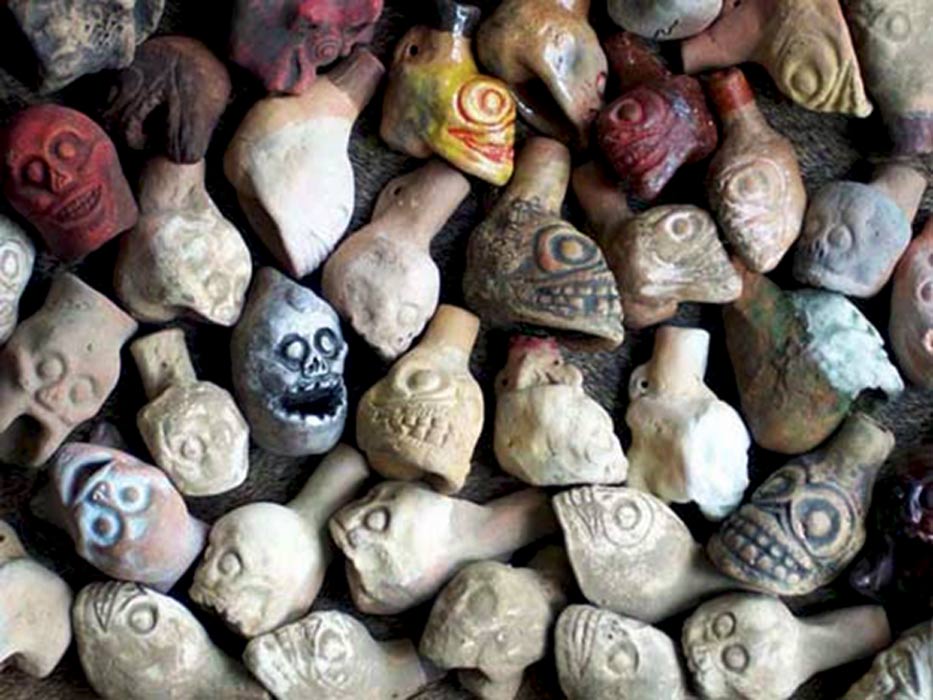
Comments
How many of these things have been found ??
The article only mentions 2 being found...both in a temple to the wind God held by a victim of sacrifice.
Not clutched in the hands of dead warriors or preists.
Specifically it mentions the rarity of these items.....then goes on to speculate about them being used in large numbers.
Left me with many questions. The article posted more speculation than actual facts.
WarwickLewis
In other news, water is wet. What kind of fake revelation is this?
That sounds like a woman being murdered. I couldn't even imagine hundreds of those coming at me all at once... I had nightmares about just that however when I was very young. Passed it off as just silly fears that accompanied being young, but as I got older I realized that that stuff did exist. I think thats gotta be the most terrifying part of this whole thing.
can sound like a Very angry falcon.
I think these death whistles were used during sacrfices and in battle. Can you imagine the shear terror they'd create in the mnds of the faithful and the foe? Psychological warfare at its finest I suspect. Nothing like using fear to control people OR preparing the enemies mind for defeat. Works every time!
Pages